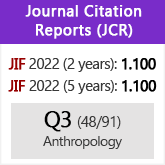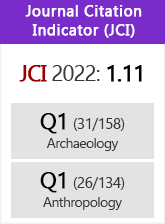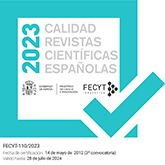Society, ideology and constructed environments during the Protohistory of the Eastern Meseta: El Ceremeño de Herrería as a case study
DOI:
https://doi.org/10.3989/tp.2007.v64.i1.97Keywords:
Iron Age, Iberian plateau, Cultural landscape, Built environment, Domestic space, Society, IdeologyAbstract
The current application of theoretical and methodological schemes coming from Landscape Archaeology provides the investigation of the pre-Roman world of the Iberian Peninsula with some useful tools for the reconstruction of the rationality patterns prevailing in that period. However, this perspective has not yet found a substantial echo among the scholars working on the Protohistoric cultures of the Eastern border of the Spanish plateau, where recent excavations and surveys provide particularly valuable evidence for undertaking this line of research. Therefore, this paper focuses on the analysis of the social and symbolic meaning of the successive urban layouts of the pre-Roman settlement of El Ceremeño at Herrería (Guadalajara, Spain). The configuration of the different spaces built there is analysed, first by considering the structural and functional relationship of the different buildings within the settlement, and later by examining the relationship of the settlement itself with other settlements in the same environment.
Downloads
References
Arenas, J.A. 1988: “El poblado celtíbero-romano de “La Huerta del Marqués” (Herrería, Guadalajara)”. I Congreso de Historia de Castilla-La Mancha, Tomo IV. Romanos y Visigodos: Hegemonía cultural y cambios sociales. Junta de Comunidades de Castilla-La Mancha (Ciudad Real 1985): 171-181. Ciudad Real.
Arenas, J.A. 1999a: La Edad del Hierro en el Sistema Ibérico Central, España. B.A.R., International Series S780. Oxford.
Arenas, J.A. 1999b: “Comercio protohistórico: líneas de contacto entre Levante y el Sistema Ibérico”. En F. Burillo (coord.): IV Simposio sobre Celtíberos: Economía (Daroca 1997): 301-309. Zaragoza.
Arenas, J.A. y Cortés, M.L. 1994: “Mortuary rites in the Celtiberian cemetery of Aragoncillo (Guadalajara, Spain)”. En W. H. Waldren et alii (eds.): Ritual, Rites and Religion in Prehistory. IIIrd Deya International Conference of Prehistory (Deyá 1993). B.A.R., International Series 611. II. Oxford.
Arenas, J.A. y Tabernero Galán, C. 1999: “Medio urbano-Medio rural: la configuración de dos mundos en la Celtiberia Citerior”. En F. Burillo (coord.): IV Simposio sobre los Celtíberos: Economía (Daroca 1997). Institución Fernando el Católico: 527-535. Zaragoza.
Arnanz, M. 2002: “Macrorrestos vegetales de El Ceremeño (Herrería, Guadalajara)”. En M.L. Cerdeño y P. Juez (eds.): El Castro Celtibérico de “El Ceremeño” (Herrería, Guadalajara). Seminario de Arqueología y Etnología Turolense y Junta de Comunidades de Castilla- La Mancha. Teruel: 133-137.
Barret, J. 1999 [1ª edición 1994]: “Defining domestic space in the Bronze Age of Southern Britain”. En M. Parker Pearson y C. Richards (eds.): Architecture and Order: Approaches to Social Space. Routledge. London: 87-97.
Ayán Vila, X.M. 2003: “Arquitectura como tecnología de construcción de la realidad social”. Arqueología de la Arquitectura 2: 17-24.
Berrocal-Rangel, L. 1994: El altar prerromano de Capote. Ensayo etno-arqueológico de un ritual céltico en el suroeste peninsular. Universidad Autónoma de Madrid.
Bowden, M. y Mcomish, D. 1987: “The required barrier.” Scottish Archaeological Review 4: 76-84.
Burillo, F. 1998: Los Celtíberos. Etnias y Estados. Crítica. Barcelona.
Burillo, F. 2003: “Segeda, Arqueología y Sinecismo”. Archivo Español de Arqueología 76: 193-215.
Burillo, F. y Ortega, J. 1999: “El proceso de formación de las sociedades campesinas en el Sistema Ibérico (1400-400 a.C.): algunas consideraciones acerca del concepto de “ruptura””. En J.A. Arenas y M.V. Palacios (eds.): El Origen del Mundo Celtibérico. Ayuntamiento de Molina de Aragón. Guadalajara: 123-140.
Cerdeño, M.L. y Juez, P. 2002: El Castro Celtibérico de “El Ceremeño” (Herrería, Guadalajara). Seminario de Arqueología y Etnología Turolense y Junta de Comunidades de Castilla-La Mancha. Teruel.
Cerdeño, M.L.; Marcos, F. y Märtens, G. 2002: “Primeras noticias sobre la necrópolis de Herrería (Guadalajara)”. En E. García Soto y M. A. García Valero (eds.): Actas del Primer Simposio de Arqueología de Guadalajara. II. (Sigüenza 2000). Junta de Comunidades de Castilla-La Mancha: 425-434. Madrid.
Collis, J. 2001: “Hill-forts, enclosures and boundaries”. En T.C. Champion y J. Collis (eds.): The Iron Age in Britain and Ireland: Recent Trends. J.R. Collis Publications: 87-94. Sheffield.
Criado Boado, F. 1993: “Límites y posibilidades de la Arqueología del Paisaje”. Spal 2: 2-55.
Criado Boado, F. 1999: Del terreno al espacio: planteamientos y perspectivas para la arqueología del paisaje. Colección CAPA 6. Laboratorio de Arqueoloxía e Formas Culturais. Santiago de Compostela.
Douglas, M. 1972: “Symbolic orders in the use of domestic space”. En P.J. Ucko, R, Tringham y G.W. Dimbledy (eds.): Man, Settlement and Urbanism. Duckworth: London: 13-22.
Fernández-Posse, M.D. y Sánchez-Palencia, F.J. 1998: “Las comunidades campesinas en la cultura castreña”. Trabajos de Prehistoria 55 (2): 127-150.
Giles, M. y Parker Pearson, M 1999: “Learning to Live in the Iron Age: dwelling and praxis”. En B. Bevan (ed.): Northern Exposure: interpretative devolution and the Iron Ages in Britain. Leicester Archaeology Monographs 4. University of Leicester. Leicester: 217- 231.
Hernando, A. 1999: “El espacio no es necesariamente un lugar: en torno al concepto de espacio y sus implicaciones en el estudio de la Prehistoria”. Arqueología Espacial 21: 7-27.
Hingley, R. 1990: “Domestic organization and gender relations in Iron Age and Romano-British households”. En R. Samson (ed.): The social archaeology of houses. Edimburg: 125-147.
Ingold, T. 1992 [1ª edición 1992]: “Culture and the Perception of the Enviroment. Culture, enviroment and development”. En E. Croll, y D. Parkin (eds.): Bush Base: Forest Farm. Routledge. London-New York: 39- 56.
Kent, S. 1993 [1ª edición 1990]: “Activity and architecture: an interdisciplinary view of the relationship between use of space and domestic built environments”. En S. Kent (ed.): Domestic architecture and the use of space. Cambridge University Press. Cambridge: 1-8.
Myrtum, H.; Gathercole, C. y Fenwick, H. 1996: “Hillfort sitting and monumentality: Castell Henllys and geographical information systems”. Archaeology in Wales 36: 3-10.
Ortega, J. 1999a: “Microespacio y Microhistoria: La Arqueología del espacio doméstico”. Arqueología Espacial 21: 101-115.
Ortega, J. 1999b: “Al margen de la <<identidad cultural>>: historia social y económica de las comunidades campesinas celtíberas”. En F. Burillo (coord.): IV Simposio sobre Celtíberos: Economía (Daroca 1997). Institución Fernando el Católico: 417-452. Zaragoza.
Parcero Oubiña, C. 1995: “Elementos para el estudio de los paisajes castreños del noroeste peninsular”. Trabajos de Prehistoria 52(1): 127-144.
Parcero Oubiña, C. 2002: La construcción del paisaje social en la edad del Hierro del Noroeste Ibérico. Instituto de Estudios Galegos Padre Sarmiento (CSIC-Xunta de Galicia). Ortigueira.
Parker Pearson, M. 2001: “Food, fertility and front doors in the first Millennium BC”. En T.C. Champion y J.R. Collis (eds.): The Iron Age in Britain and Ireland: Recent Trends. J.R. Collis Publications. Sheffield: 117- 132.
Parker Pearson, M. y Richards, C. 1999a [1ª edición 1994]: “Ordering the world: Perceptions of architecture, space and time”. En M. Parker Pearson y C. Richards (eds.): Architecture and order: Approaches to Social Space. Routledge. London-New York: 1-37.
Parker Pearson, M. y Richards, C. 1999b [1ª edición 1994]: “Architecture and Order: spatial representation and archaeology”. En M. Parker Pearson y C. Richards (eds.): Architecture and Order: Approaches to Social Space. Routledge. London-New York: 38-72.
Rapoport, A. 1993 [1ª edición 1990: “Systems of Activities and Systems of Settings”. En S. Kent (ed.): Domestic Architecture and the Use of Space. Cambridge University Press. Cambridge: 9-20.
RAPOPORT, A. 1998: “Spatial organization and the built enviroment”. En T. Ingold (ed.): The Companion Encyclopedia of Anthropology. Routledge. London-New York: 460- 502.
Rodríguez-Calderot, G. et alii 2006: “Observaciones topoastronómicas en la Zona Arqueológica de El Ceremeño (Herrería, Guadalajara)”. Complutum 17: 133-143.
Sanders, D. 1993 [1ª edición 1990]: “Behavioral conventions and archaeology: methods for the analysis of ancient architecture”. En S. Kent (ed.): Domestic Architecture and the Use of Space. Cambridge University Press. Cambridge: 43-72.
Sharples, N. 1991: “Warfare in the Iron Age of Wessex”. Scottish Archaeological Review 8: 79-89.
Valdés, M.V. 2002: “Análisis químico de los sedimentos, realizado con muestras del castro “El Ceremeño” (Guadalajara)”. En M.L. Cerdeño y P. Juez (eds.): El Castro Celtibérico de “El Ceremeño” (Herrería, Guadalajara). Seminario de Arqueología y Etnología Turolense y Junta de Comunidades de Castilla-La Mancha. Teruel: 159-167.
Downloads
Published
How to Cite
Issue
Section
License
Copyright (c) 2007 Consejo Superior de Investigaciones Científicas (CSIC)

This work is licensed under a Creative Commons Attribution 4.0 International License.
© CSIC. Manuscripts published in both the printed and online versions of this Journal are the property of Consejo Superior de Investigaciones Científicas, and quoting this source is a requirement for any partial or full reproduction.All contents of this electronic edition, except where otherwise noted, are distributed under a “Creative Commons Attribution 4.0 International” (CC BY 4.0) License. You may read here the basic information and the legal text of the license. The indication of the CC BY 4.0 License must be expressly stated in this way when necessary.
Self-archiving in repositories, personal webpages or similar, of any version other than the published by the Editor, is not allowed.

















